
11 minute read
Next Stop, Shippensburg Station
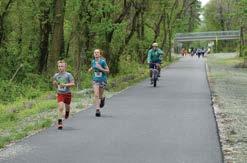
Last April, the university and community celebrated the addition of a new bridge and paved trail extension from Shippensburg Township Park through campus. Walkers, runners, and bikers enjoyed the trail as part of the Cumberland Valley Rails-to-Trails Council Race, Run, Ride, and Ramble fundraiser.
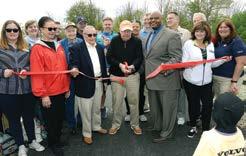
The rails that physically divided the town of Shippensburg nearly one hundred years ago are now strengthening the connection between the university and downtown communities as plans surrounding the Cumberland Valley Rail Trail steam ahead.
For years, a sign at the edge of campus proclaimed the trail was under development. Graduating classes for more than a decade wondered if plans to enhance the old “goat path” would ever come to fruition. When Dr. Allen Dieterich-Ward started teaching history at Ship, he had the same thought.
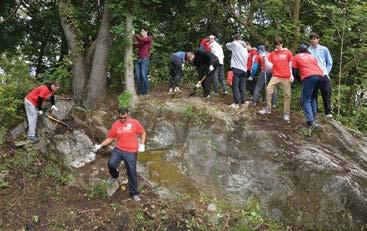
The university community helps maintain the trail.
“I love rail trails and have studied them a lot,” he said. “We moved here in 2006, and one of the first things I noticed was the ‘trail under development’ sign. Year after year, the sign never changed, and I wondered what the deal was.”
The forces that derailed the trail were complicated, but not impossible to overcome. The Cumberland Valley Rails-to-Trails Council (CVRTC), which owned the stretch of trail through campus, needed funding and a solid partner, namely the university, Dieterich-Ward said. Once that happened, the trail development was on a fast track.
Over the past year, the CVRTC celebrated the opening of a new bridge over Foglesonger Road, a paved expansion through campus, the addition of a comfort station at the trailhead off Earl Street, and the acquisition and relocation of an original Penn Central boxcar. On April 21, the university and several downtown partners will host TrailFest, a combined race and BrewFest held at the newly established trailhead off Earl Street. The community event will cap off a week of activities surrounding President Laurie Carter’s inauguration on April 20. Organizers are excited that this most recent partnership between the university, the CVRTC, and downtown organizations will revitalize town and create future opportunities.
“I feel like we have a movement right now, and we can really make a difference,” Dieterich-Ward said.
Chugging Along
For nearly twenty years, the CVRTC has developed the former Cumberland Valley Railroad into an eleven-mile, multipurpose recreation trail. The section through Shippensburg Township Park was completed in 2006, but the stretch through campus sat relatively untouched.
Dr. Paul Taylor, associate professor of mathematics, used the trail with his wife and started attending CVRTC meetings about ten years ago. “At the time I joined, the trail from Shippensburg Township Park to Newville was completed, and we were trying to keep it maintained,” he said. “We owned the stretch through Ship’s campus, but didn’t have the money to improve it.”
About five years ago, the CVRTC received a grant to complete the trail on Ship’s campus, Taylor said. After dealing with a few practical issues, they started clearing out the trail in 2016. Last spring, the CVRTC, university, and local partners worked to install a new bridge over Fogelsonger Road and pave the mile of trail through campus.
“It’s very exciting to think that for so long, we were just trying to keep the grass from getting too tall. Now the trail is through campus, and campus seems more excited about it,” Taylor said.
Dieterich-Ward, who also sits on the CVRTC, was thrilled to have the trail extended, but envisioned more. “It was time for me to give back and lend support to the trail. I knew the trail was finally getting built through campus, but I wanted to make sure community needs were being met, not just recreational needs.”
He pictured the project as an urban trail going through the heart of the community. To make that vision a reality, the rail trail had to be visible and easily accessible. Dieterich-Ward heard the Shippensburg Rotary Club wanted to build a comfort station, so he joined Rotary to help.
“I could see how all the pieces were fitting together,” he said. “I wanted to help with building the comfort station and use my university connections.”
Last fall, Shippensburg Township and the Shippensburg Rotary Club jointly funded the comfort station located at the new CVRT parking area at the corner of Fort and Earl streets. The multi-use event and performance space will continue to evolve with upgraded parking, a Pennsylvania Railroad signal, a performance stage, and more.
“The Rotary Club of Shippensburg is very proud of our collaborative effort with Shippensburg Township, the CVRTC, and Shippensburg University,” said Gary Davis, Rotary president. “We have been meeting for two years now, and Rotarians have donated over 200 volunteer hours to the comfort station project. Our hope is that the entire community will continue to work together for the betterment of the greater Shippensburg area.”
No longer sidelined by its previous stumbling blocks, it seemed the CVRT was moving full speed ahead. Now it just needed a statement piece.
Dream Train
Hidden in the trees at the end of Queen Street near the old Hoffman Mills building was a railroad enthusiast’s dream—an abandoned, uniquely green Penn Central boxcar.
“All of us railroad enthusiasts had known it was back there,” said Jim Stanton ’00, a member of the Conrail Historical Society. “In the winter when you’d hike the trail you could see it. It was a jungle back there. …It was hard to get pictures of it, but it was neat to see a relic.”
It’s not unusual for railroad enthusiasts also to be photographers, Stanton said. When the plant was scrapped in 2016, he was certain it was the end of the line for its neighboring boxcar. So, he grabbed his camera. “I photographed it as much as possible, so that when it became tin cans and razor blades, there was a historical record.”
Coincidentally, Stanton and Taylor are neighbors. Stanton knew Taylor served on the CVRTC, so he mentioned the boxcar, suggesting it could serve as a welcome center off Britton Road. “Paul said, ‘I need to introduce you to a guy. Allen.’ He knew things I didn’t know. Allen’s the dynamo, but he needed to find the people who could make the right things happen.”
Dieterich-Ward received the news from Taylor. “I went over immediately and was blown away by (the boxcar). It was abandoned for thirty years, but was structurally sound. I was just amazed it wasn’t torn down.”
Relocating the boxcar next to the Rotary Club’s comfort station would provide that eye-catching addition to the trail and create another tourist attraction in the community. It was just a matter of making it happen. Fortunately, Stanton said Dave’s Truck Repair in Chambersburg fit the bill. “We found someone local, talented, and sympathetic to the price.”
As the boxcar traveled down Richard Avenue to its new home off of Earl Street, another piece of the puzzle came together. Out of curiosity one night, Jim Tabler ’10 wandered over to the site. Having formerly worked railroad maintenance, he volunteered to build a track panel to display the boxcar.
Now relocated and preparing for renovations, Stanton said the boxcar is situated in Foreman’s Triangle for the perfect photo op. “Lots of people remember the Penn Central green running through town. It’s a unique color green, so when it went by, it caught your eye.”

As the statement piece for the new trailhead, Dave’s Truck Repair of Chambersburg moves the boxcar down Richard Avenue to its new home off Fort and Earl streets.
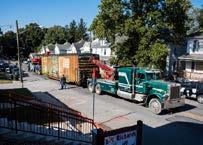
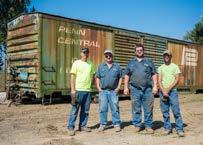
Shippensburg Station
Two things are needed to create an authentic community development, according to Dieterich-Ward—outdoor recreation and a connection to where you are. Adjacent to the trail, the boxcar provided a perfect opportunity to develop an accessible mini-museum that told the story of the Cumberland Valley Railroad. These new developments—the rail trail extension, comfort station, boxcar museum, and performance space—collectively were renamed Shippensburg Station.
For Tiffany Weaver ’09-’ 12m, the director of the Shippensburg Historical Society and one of Dieterich-Ward’s former students, this was a gift. “When Allen asked if I wanted to be involved, I said, ‘Yes, please!’ I think this is a really cool space for the community. It’s really cool to see this brought on as Shippensburg Station and provide more of a connection between the university and community.”
Thanks to a $71,000 grant through the Cumberland Area Economic Development Corporation, Weaver and Christi Fic ’15M, university archivist, are developing forty feet of exhibit space in a boxcar. The grant, provided to the CVRTC, covered renovating the boxcar’s exterior, preparing the interior for the exhibits, and purchasing materials like display cases. Weaver and Fic picture the space as mostly permanent exhibits with a theater area on one side and a place for children’s educational programming at the other.
“We really want to tell the story of the railroad in the Cumberland Valley, especially how it interacted with citizens on a day-to-day basis,” Weaver said. “It’s about their lives, the university, jobs, and the area in general—anything that makes that personal connection and makes it as inclusive as possible.”
Stanton said people have told stories about the different railroads, but no one has put the whole story of the Cumberland Valley Railroad together like this. “There weren’t many places served by three railroads,” he said. “The whole story has never been told in one place.”
At the end of March, Weaver and Fic will invite the public to an open house to view the space and learn more about their plans in hopes that people see their vision and share their railroad artifacts with the museum.
Celebrating with TrailFest
Countless pieces have come together— some by design, others by chance—over the last few years to create what is now Shippensburg Station.
April’s TrailFest celebrates the latest trail expansions and community partnerships. TrailFest couples the CVRTC’s twelfth annual Race, Run, Ride, and Ramble event with the Shippensburg Historical Society’s second annual BrewFest.
It might actually be easier to continue to host these events separately, said Mitch Burrows ’17, owner of University Grille and Shippensburg Chamber of Commerce board member. “But, to do it at this location that is more centralized for the university and downtown makes it a broader effort for everyone to be involved,” he said. “This is a lot of people’s vision… We want one overall community—the university and the local community as one.”
The daylong event will kick off with the Race, Run, Ride, and Ramble. The Brewfest will feature more than twenty breweries as well as a few wineries, and live music from local bands. “People will come out for a community event. They come for the beer, the art, or the music, and this is a combination of all of them,” he said.
Stanton is excited. He knows not everyone geeks out over railroad history like he does. That’s why all the pieces of this project are equally important. “The boxcar might be what gets someone to get out of their car, maybe even stay there. But the music, the trailhead, the event space, the restrooms, a place to picnic… that’s the beauty of Allen’s master plan. It will never be just one thing. It gives people reasons to come back.”
And although the journey can be stressful, Dieterich-Ward said the rewards are sweet. “It has been so gratifying to find out people’s passions and put it all together in the thing we’re calling Shippensburg Station. …If we care about our community we can make it a better place.”

The boxcar is placed on its new rail platform.
Educational Opportunities
Beyond recreation and entertainment, the extended Cumberland Valley Rail Trail provides an opportunity for students to gain practical experience through their courses.
The Shippensburg Station boxcar museum gave students from Dr. Steve Burg’s fall history class a chance to consider how that exhibit might take shape. “For them to think about how to create historical context, how to connect the university and downtown, this was just a fantastic opportunity,” Burg said. “To be able to add that layer of history on is just perfection.”
Senior Tyler Newcomer said the class received a budget and focused on why the public would want to visit the railroad museum. He liked the challenge of determining how to make the Cumberland Valley Railroad relevant to tourists by connecting broader themes. Each group also considered exhibit design, with his group preferring a more exposed, industrial look.
“It felt good knowing that maybe my work, or the collective class work, might be used for this project,” he said.
Rotating exhibit space is planned for the mini-museum so that future classes might contribute to the project. Burg’s class also worked to develop historic wayside markers for a walking tour.
As part of Dr. Laurie Cella’s Introduction to Technical Writing course, senior Kayla Morales brought the Little Free Library project to the trail. The nationwide free book exchange program strives to provide access to books for readers of all ages and backgrounds. “I was inspired by the organization’s efforts in trying to instill a love of reading in all neighborhoods all over the world, and I felt that reading was a great way to unify the Shippensburg community,” Morales said.
When Dr. Allen Dieterich-Ward asked Professor Steve Dolbin if he would provide art along the trail, Dolbin realized it was a perfect project for his Basic Sculpture class. Each fall, Dolbin assigns students an environmental installation piece, which they typically completed in their hometown. Of the two Basic Sculpture classes last fall, students completed eight pieces along the trail. The Cumberland Valley Rails-to- Trails Council loved it, Dolbin said, and he’s now working on concrete pads to regularly display these pieces along the trail.
“We need to build bonds with the community. It not only shows how much we love the community, but it’s something everyone can come together to support.”

The rail trail and boxcar projects created opportunities for student involvement, such as environmental art installations and researching the history of the Cumberland Valley Railroad for a local walking tour.




